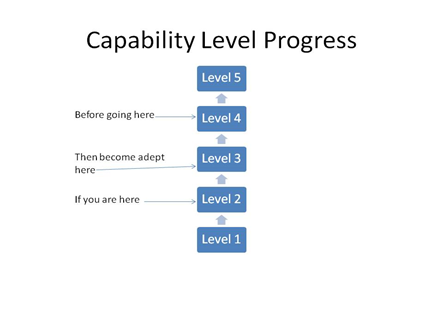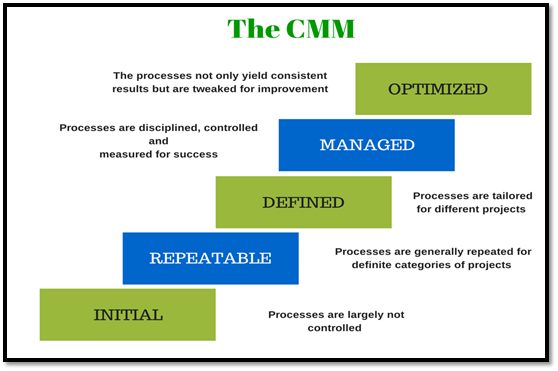Measuring the maturity of an organization’s data management capabilities against a standard model provides structure and the ability to gauge progress over time
Introduction
Organizations do not know how to treat data as an asset. As evidenced by the fact that many organizations do not or cannot control the data they capture and store for it to produce business value, many organizations need to improve the quality of their management of data and information. However, they do not know the current state of their data and information management capabilities, so they do not know where to focus their resources, what activities are performing well and which are struggling, and how they can make adjustments effectively.
One process improvement technique used in many information technology disciples is a “Capability Maturity Model” (CMM), based on the work of Watts Humphrey at IBM. This model strives to assist organizations in improving the quality a discipline’s processes through refining those processes to a level of “maturity”, meaning that these processes have a high predictability of results and low risk of encountering unknown variables or situations. The model takes an organization through five scales, from Level 1 (Initial) through Level 5 (Optimizing), and measures the operation’s effectiveness at each level based on assessment of certain areas (Key Process Areas).
Structure of a Maturity Model
An effective maturity model is intended to be a cohesive, coherent, ordered set of incremental improvements, all relating to experienced success in the field, and packaged into a framework that demonstrates how effective practices can be built on one another into a logical and repeatable progression. Far from a “quick fix,” the use of any maturity model, and especially a data management-focused model, requires a strategic view, attention to detail, support and participation from senior management and a rational approach to all aspects of enterprise data management planning and implementation.
Most well-designed maturity models are structured in levels so the model can represent the series of effective capabilities that must be achieved before progressing to the next level. The model assumes that the organization or individual will become skilled when performing the collection of related activities at one level before moving to the next level in the sequence. For a data management maturity assessment, the assessors must be experienced in all areas of enterprise data management.

Most valid maturity models, regardless of the domain they address or the organization that developed the model, follow a similar structure. Names of the levels may be changed by the developing organization, but the intent of each level should be clearly stated. Over the years, research has shown that models with fewer than five (5) capability levels are too broad for objective, thorough, and incremental improvement analysis.
- Initial Level (also known as ad-hoc, immature): At the initial level, the organization typically does not provide a stable, consistent environment for managing the domain (software development, projects, enterprise data management, etc) and its activities. At this level, an organization lacks consistent domain practices. Therefore, the benefits of good, integrated domain development practices are undermined by ineffective planning and reaction-driven commitment efforts. Only heroic activities can accomplish positive results, and there are few if any repeatable processes for the domain across (and possibly within) units of the organization for the domain’s actions.
- Repeatable Level: At the repeatable level, policies for managing the domain’s processes and procedures to implement those policies are established. Effective management processes for development projects are institutionalized, which allow organizations to repeat successful practices developed on earlier projects, although the specific processes implemented by the projects may differ. Some professional staff for the domain may have been engaged to lead domain efforts, and the need for a domain strategy at an enterprise level may have surfaced.
- Defined Level: At the defined level, the strategy for managing the domain has been completed and an enterprise implementation plan has been started. Standard processes for domain management are being documented; the processes are based on industry standard best practices, and are integrated into a coherent whole. Processes are used to help the managers, team leaders, and various team members perform more effectively. The domain is recognized across most of the organization as necessary and the domain staff functions in most efforts with little resistance, due to increasing cultural acceptance.
- Managed Level: At the managed level, the organization establishes metrics for the domain’s products and processes, and measures the results for the entire domain. The domain’s enterprise strategy has been implemented and the domain has achieved control over the processes by narrowing the variation in their process performance to fall within acceptable boundaries. Meaningful variations in process performance can be distinguished from random variation (noise). Socialization of the domain is part of the culture, and the staff for the domain is fully funded as part of the organization.
- Optimized Level: At the optimized level, the entire organization is focused on continuous process improvement. The organization has the means to identify weaknesses and strengthen the process proactively, with the goal of preventing the occurrence of defects. Data on the effectiveness of the domain’s processes is used to perform cost benefit analyses of new technologies and proposed changes to the organization’s domain’s processes. Innovations that exploit the best-integrated domain practices are identified and transferred throughout the organization, seamlessly.
Benefits to Using a Maturity Model
Many forms of a Capability Maturity Model have been created since the first one was created in 1991 (CMM-SW). Regardless of the domain (software development, IT infrastructure, human resources, supply chain management, enterprise data management, etc…) all maturity models share some benefits to use:
- More accurate identification of flaws in process development operations
- Reduction in cost the process’ implementation and maintenance
- Increase in productivity from the domain’s professionals (staff and contractors)
- Reduction in post-release defects and essential enhancements
- Reduction in time-to-market for domain product implementation
A Data Management Maturity Model
A Data Management Maturity Model should be based on actual industry practices, as the Capability Maturity Model was. A solid Data Management Maturity Model should reflect the best practices of the industry and should indicate the needs of individuals performing all of the activities found in the domain of enterprise data management. Additionally, a valid Data Management Maturity Model should have dimensions of environmental factors for measurement to account for the issues and challenges found within an organization.
Major components of a robust, stable, scalable and effective Data Management Maturity Model would include:
- Acknowledgement of comprehensive nature of enterprise data management (view of entire domain)
- Treatment of each component / discipline within domain as a discrete part of the domain and model:
- Data Governance
- Metadata Management
- Data Architecture
- Data Operations
- Master and Reference Data Management
- Data Warehousing and Business Intelligence
- Data Integration
- Data Security
- Data Quality
- Treatment of each component / discipline against each Environmental Factor. Examples of Environmental Factors could include:
- Sponsorship and Goals
- Principles, Attitudes, Beliefs
- Cultural Readiness and Adoption
- Metrics and Business Value
- Practices and Processes
- Roles and Organizational Structures
- Technologies
- Skills, Training and Experience
- Key Process Indicators for each Level 1-5 for each part of the domain against each Environmental Factor
- Assessment capabilities (survey questions, scoring methods, results evaluation, etc..) to provide insight into current state of client’s data management situation and desired target state
Conclusion
Every organization performs data management activities, and every organization can improve their performance of enterprise data management processes. Using a Data Management Maturity Model developed by industry experts that encompasses the entire domain of data management as the foundation for assessing the current state and planning the improvement path can provide many lasting benefits for any organization.







